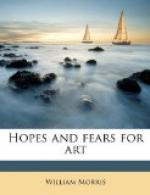Now to sum up: This method of pattern-designing must be considered the Western and civilised method; that used by craftsmen who were always seeing pictures, and whose minds were full of definite ideas of form. Colour was essential to their work, and they loved it, and understood it, but always subordinated it to form.
There is next the method of relief by placing a dark figure on a light ground. Sometimes this method is but the converse of the last, and is not so useful, because it is capable of less variety and play of colour and tone. Sometimes it must be looked on as a transition from the last-mentioned method to the next of colour laid by colour. Thus used there is something incomplete about it. One finds oneself longing for more colours than one’s shuttles or blocks allow one. There is a need felt for the speciality of the next method, where the dividing line is used, and it gradually gets drawn into that method. Which, indeed, is the last I have to speak to you of, and in which colour is laid by colour.
In this method it is necessary that the diverse colours should be separated each by a line of another colour, and that not merely to mark the form, but to complete the colour itself; which outlining, while it serves the purpose of gradation, which in more naturalistic work is got by shading, makes the design quite flat, and takes from it any idea of there being more than one plane in it.
This way of treating pattern design is so much more difficult than the others, as to be almost an art by itself, and to demand a study apart. As the method of relief by laying light upon dark may be called the Western way of treatment and the civilised, so this is the Eastern, and, to a certain extent, the uncivilised.
But it has a wide range, from works where the form is of little importance and only exists to make boundaries for colour, to those in which the form is so studied, so elaborate, and so lovely, that it is hardly true to say that the form is subordinate to the colour; while, on the other hand, so much delight is taken in the colour, it is so inventive and so unerringly harmonious, that it is scarcely possible to think of the form without it—the two interpenetrate.
Such things as these, which, as far as I know, are only found in Persian art at its best, do carry the art of mere pattern-designing to its utmost perfection, and it seems somewhat hard to call such an art uncivilised. But, you see, its whole soul was given up to producing matters of subsidiary art, as people call it; its carpets were of more importance than its pictures; nay, properly speaking, they were its pictures. And it may be that such an art never has a future of change before it, save the change of death, which has now certainly come over that Eastern art; while the more impatient, more aspiring, less sensuous art which belongs to Western civilisation may bear many a change and not die utterly; nay, may feed on its intellect alone for a season, and enduring the martyrdom of a grim time of ugliness, may live on, rebuking at once the narrow-minded pedant of science, and the luxurious tyrant of plutocracy, till change bring back the spring again, and it blossoms once more into pleasure. May it be so.




